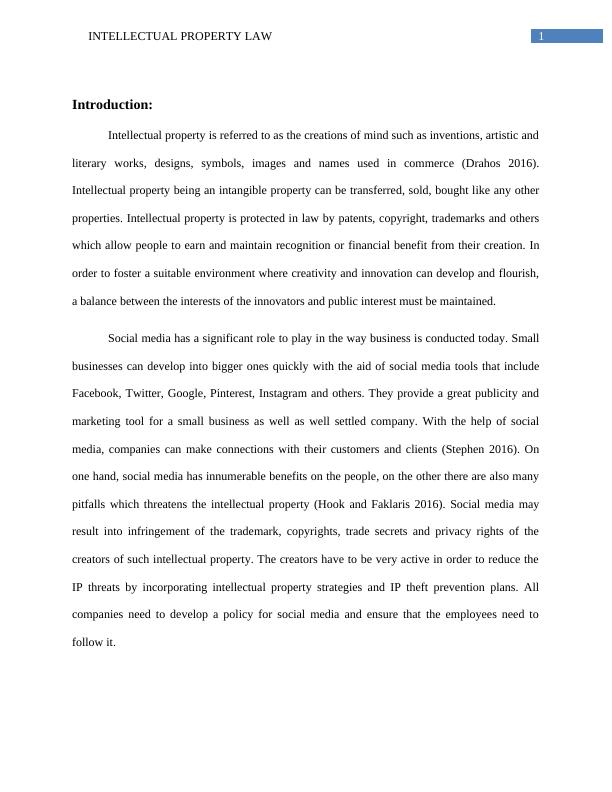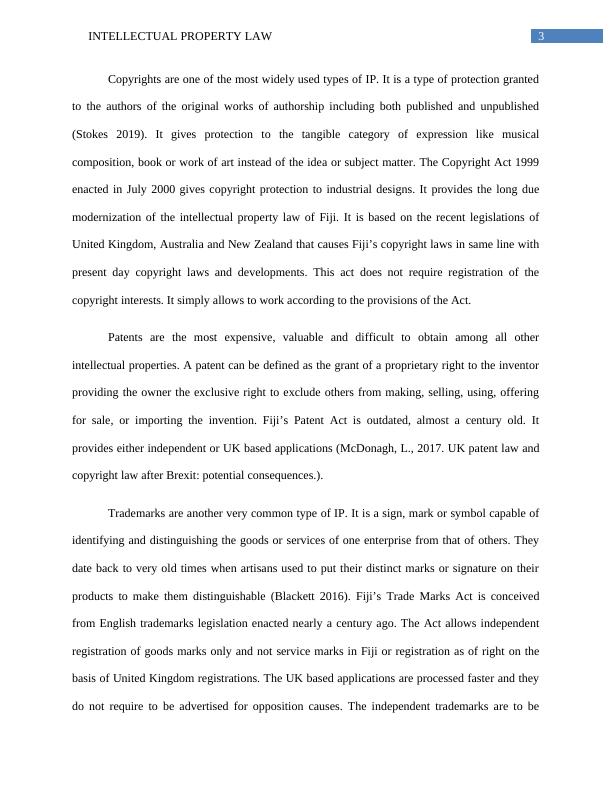Intellectual Property Law
Added on 2023-04-23
12 Pages3262 Words265 Views
Running head: INTELLECTUAL PROPERTY LAW
INTELLECTUAL PROPERTY LAW
Name of the Student:
Name of the University:
Author Note:
INTELLECTUAL PROPERTY LAW
Name of the Student:
Name of the University:
Author Note:

1INTELLECTUAL PROPERTY LAW
Introduction:
Intellectual property is referred to as the creations of mind such as inventions, artistic and
literary works, designs, symbols, images and names used in commerce (Drahos 2016).
Intellectual property being an intangible property can be transferred, sold, bought like any other
properties. Intellectual property is protected in law by patents, copyright, trademarks and others
which allow people to earn and maintain recognition or financial benefit from their creation. In
order to foster a suitable environment where creativity and innovation can develop and flourish,
a balance between the interests of the innovators and public interest must be maintained.
Social media has a significant role to play in the way business is conducted today. Small
businesses can develop into bigger ones quickly with the aid of social media tools that include
Facebook, Twitter, Google, Pinterest, Instagram and others. They provide a great publicity and
marketing tool for a small business as well as well settled company. With the help of social
media, companies can make connections with their customers and clients (Stephen 2016). On
one hand, social media has innumerable benefits on the people, on the other there are also many
pitfalls which threatens the intellectual property (Hook and Faklaris 2016). Social media may
result into infringement of the trademark, copyrights, trade secrets and privacy rights of the
creators of such intellectual property. The creators have to be very active in order to reduce the
IP threats by incorporating intellectual property strategies and IP theft prevention plans. All
companies need to develop a policy for social media and ensure that the employees need to
follow it.
Introduction:
Intellectual property is referred to as the creations of mind such as inventions, artistic and
literary works, designs, symbols, images and names used in commerce (Drahos 2016).
Intellectual property being an intangible property can be transferred, sold, bought like any other
properties. Intellectual property is protected in law by patents, copyright, trademarks and others
which allow people to earn and maintain recognition or financial benefit from their creation. In
order to foster a suitable environment where creativity and innovation can develop and flourish,
a balance between the interests of the innovators and public interest must be maintained.
Social media has a significant role to play in the way business is conducted today. Small
businesses can develop into bigger ones quickly with the aid of social media tools that include
Facebook, Twitter, Google, Pinterest, Instagram and others. They provide a great publicity and
marketing tool for a small business as well as well settled company. With the help of social
media, companies can make connections with their customers and clients (Stephen 2016). On
one hand, social media has innumerable benefits on the people, on the other there are also many
pitfalls which threatens the intellectual property (Hook and Faklaris 2016). Social media may
result into infringement of the trademark, copyrights, trade secrets and privacy rights of the
creators of such intellectual property. The creators have to be very active in order to reduce the
IP threats by incorporating intellectual property strategies and IP theft prevention plans. All
companies need to develop a policy for social media and ensure that the employees need to
follow it.

2INTELLECTUAL PROPERTY LAW
Discussion:
From business and social networking sites like Facebook, Instagram and LinkedIn to
media sharing platforms of YouTube, social media has a bunch of opportunities to offer to the
business owners to promote their skills, company or ideas and now it provides a key part of
various business marketing strategy (Sajid 2016). As said above, the growth in the importance of
social media also comes with new problems and challenges. One of them is the risk of
infringement of intellectual property or infringement of IP rights belonging to third parties.
Hence, it is important that the companies monitor their IP and ensure that it is saved from
infringement.
Intellectual property is a general term for a bunch of intangible assets owned and legally
protected by a company from outside use or using without proper permission (Hook, S.A., 2017.
Intellectual Property: Nuts and Bolts.). An organization that owns IP can get valuation from it in
different ways, through using it internally for its own processes or sharing it externally. The
latter is done through legal processes such as loyalty rights.
There lies an elaborate international system that defines, protects and enforces intellectual
rights properties through multilateral treaties and international organizations like World
Intellectual Property Organization (WIPO), Trade Related Aspects of Intellectual Property
Rights (TRIPs), United Nations Commission on International Trade law (UNCITRAL), World
Customs Organization (WCO) and European Union (EU).
IP forms an asset category that can be divided into four different types like copyrights,
patents, trademarks and designs.
Discussion:
From business and social networking sites like Facebook, Instagram and LinkedIn to
media sharing platforms of YouTube, social media has a bunch of opportunities to offer to the
business owners to promote their skills, company or ideas and now it provides a key part of
various business marketing strategy (Sajid 2016). As said above, the growth in the importance of
social media also comes with new problems and challenges. One of them is the risk of
infringement of intellectual property or infringement of IP rights belonging to third parties.
Hence, it is important that the companies monitor their IP and ensure that it is saved from
infringement.
Intellectual property is a general term for a bunch of intangible assets owned and legally
protected by a company from outside use or using without proper permission (Hook, S.A., 2017.
Intellectual Property: Nuts and Bolts.). An organization that owns IP can get valuation from it in
different ways, through using it internally for its own processes or sharing it externally. The
latter is done through legal processes such as loyalty rights.
There lies an elaborate international system that defines, protects and enforces intellectual
rights properties through multilateral treaties and international organizations like World
Intellectual Property Organization (WIPO), Trade Related Aspects of Intellectual Property
Rights (TRIPs), United Nations Commission on International Trade law (UNCITRAL), World
Customs Organization (WCO) and European Union (EU).
IP forms an asset category that can be divided into four different types like copyrights,
patents, trademarks and designs.

3INTELLECTUAL PROPERTY LAW
Copyrights are one of the most widely used types of IP. It is a type of protection granted
to the authors of the original works of authorship including both published and unpublished
(Stokes 2019). It gives protection to the tangible category of expression like musical
composition, book or work of art instead of the idea or subject matter. The Copyright Act 1999
enacted in July 2000 gives copyright protection to industrial designs. It provides the long due
modernization of the intellectual property law of Fiji. It is based on the recent legislations of
United Kingdom, Australia and New Zealand that causes Fiji’s copyright laws in same line with
present day copyright laws and developments. This act does not require registration of the
copyright interests. It simply allows to work according to the provisions of the Act.
Patents are the most expensive, valuable and difficult to obtain among all other
intellectual properties. A patent can be defined as the grant of a proprietary right to the inventor
providing the owner the exclusive right to exclude others from making, selling, using, offering
for sale, or importing the invention. Fiji’s Patent Act is outdated, almost a century old. It
provides either independent or UK based applications (McDonagh, L., 2017. UK patent law and
copyright law after Brexit: potential consequences.).
Trademarks are another very common type of IP. It is a sign, mark or symbol capable of
identifying and distinguishing the goods or services of one enterprise from that of others. They
date back to very old times when artisans used to put their distinct marks or signature on their
products to make them distinguishable (Blackett 2016). Fiji’s Trade Marks Act is conceived
from English trademarks legislation enacted nearly a century ago. The Act allows independent
registration of goods marks only and not service marks in Fiji or registration as of right on the
basis of United Kingdom registrations. The UK based applications are processed faster and they
do not require to be advertised for opposition causes. The independent trademarks are to be
Copyrights are one of the most widely used types of IP. It is a type of protection granted
to the authors of the original works of authorship including both published and unpublished
(Stokes 2019). It gives protection to the tangible category of expression like musical
composition, book or work of art instead of the idea or subject matter. The Copyright Act 1999
enacted in July 2000 gives copyright protection to industrial designs. It provides the long due
modernization of the intellectual property law of Fiji. It is based on the recent legislations of
United Kingdom, Australia and New Zealand that causes Fiji’s copyright laws in same line with
present day copyright laws and developments. This act does not require registration of the
copyright interests. It simply allows to work according to the provisions of the Act.
Patents are the most expensive, valuable and difficult to obtain among all other
intellectual properties. A patent can be defined as the grant of a proprietary right to the inventor
providing the owner the exclusive right to exclude others from making, selling, using, offering
for sale, or importing the invention. Fiji’s Patent Act is outdated, almost a century old. It
provides either independent or UK based applications (McDonagh, L., 2017. UK patent law and
copyright law after Brexit: potential consequences.).
Trademarks are another very common type of IP. It is a sign, mark or symbol capable of
identifying and distinguishing the goods or services of one enterprise from that of others. They
date back to very old times when artisans used to put their distinct marks or signature on their
products to make them distinguishable (Blackett 2016). Fiji’s Trade Marks Act is conceived
from English trademarks legislation enacted nearly a century ago. The Act allows independent
registration of goods marks only and not service marks in Fiji or registration as of right on the
basis of United Kingdom registrations. The UK based applications are processed faster and they
do not require to be advertised for opposition causes. The independent trademarks are to be

End of preview
Want to access all the pages? Upload your documents or become a member.
Related Documents
Advanced Intellectual Property Lawlg...
|10
|2272
|324
Intellectual Property: Protection, Plagiarism, Open Source Code, and Cybersquattinglg...
|5
|999
|246
International Intellectual Property Law PDFlg...
|15
|5608
|227
Trademark Protection and E-Commercelg...
|16
|6189
|320
Intellectual Property Law : Reportlg...
|17
|4733
|369
Issues and Challenges Faced by Entrepreneurs in Intellectual Propertylg...
|10
|2954
|228
